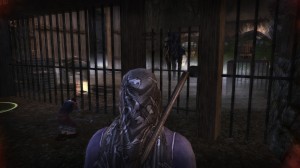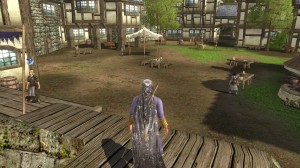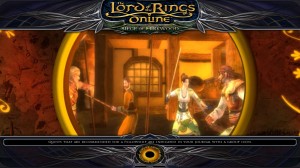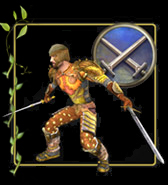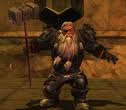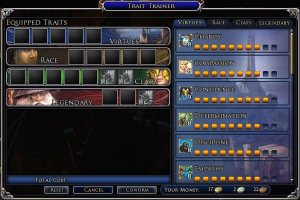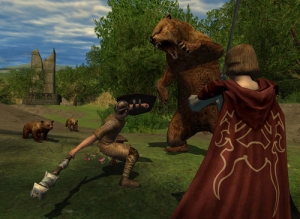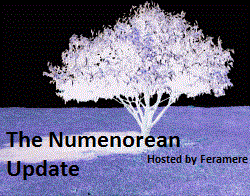The Geography of Numenor
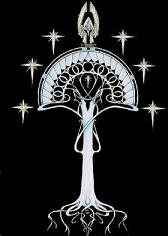 This weeks new part to the Lore of Numenor is the Geography! In this post I will focus about the different Regions throughout Numenor’s Realm. I hope you enjoy the second part in my lore series on Numenor!
This weeks new part to the Lore of Numenor is the Geography! In this post I will focus about the different Regions throughout Numenor’s Realm. I hope you enjoy the second part in my lore series on Numenor!
** Note, this post was not written by me but by a friend of mine who is huge on Middle Earth Lore. The layout is also funky and was almost impossible to edit in this standard post entry view on wordpress. I will try to mess around with the layout, so if you cant seem to read it now, just wait a little till I have it tweaked**
The nature of the land itself is most fully related in A Description of the Island of Númenor, a text published in Unfinished Tales and claimed by Tolkien to have been derived from the archives of Gondor.
The island of Númenor was situated in the Great Sea, closer to the Blessed Realm than to Middle-earth. In shape it resembled a five-pointed star, with five large peninsulas extending from the central region. The latter is stated to have been around 250 miles (400 km) or 400 kilometres across, and promontories were nearly of the same length each. The island itself was “tilted southward and a little eastward”.
Forostar or “Northlands”
The northern peninsula of Númenor, described as rocky and the least fertile. Most of the landscape was formed by “high heather-covered moors”, which in the north rose to rocky hills. The only trees in the Forostar were firs and larchesthat grew upon the westward slopes of the moors; the stone quarried in the region was the most esteemed for building. It is also stated that in this land “the airs were clearest”, and that for this reason King Tar-Meneldur built in the northern parts of Forostar a tall tower to watch the stars.
-
- Andustar or “Westlands”
- A generally fertile and wood-covered region, which became rocky to the north. The western coastline was formed by high cliffs, in which three small bays were cut; several harbours were built in these bays, upon thin shelving land at the feet of steep hills. The northern highlands were covered by fir-woods, while in the south the forests consisted mainly of birches and beeches upon the upper ground and of oaks and elms in vales. The Andustar was separated from the Hyarnustar in the south by the wide Bay of Eldanna, and a small borderland that remained was called the Nisimaldar.
- Hyarnustar or “Southwestlands”
- This promontory was noted for the great vineyardss and fertile farmlands in its eastern half, which in the southwest gave way to highlands with great cliffs along the coast. In the far east were “wide white beaches and grey shingles”, with numerous villages such as Nidamos, and the marshes formed by the river Siril
- Orrostar or “Eastlands”
- A cool but fertile region of the island, rising to highlands in the north and flat to the south. In the south-western parts of the Orrostar were vast plantations of grain
- Mittalmar or “Inlands”
- The central part of Númenor, land-locked except for a small coast around the haven of Rommena in the east. The Mittalmar is described as “raised above the promontories”, and as a region of grasslands, pastures and low downs with few trees
- Arandor or “Kingsland”
- The eastern part of the Mittalmar that was considered separate from the rest and was under direct jurisdiction of the King. It is stated to have been “at all times the most populous region of Númenor”, and here the capital Armenelosand the haven Rómenna were situated.
-
EmeriëThe south-western areas of the Mittalmar with “rolling downs of grass”, and the chief region of sheep pasturage. A portion of Emerië was granted by Tar-Meneldur to Erendis, the bride of his son Aldarion, and into this land she retired after their breach.NísimaldarA land around the eastern shores of the Bay of Eldanna and the estuary of river Nunduinë. The name is translated as “Fragrant Trees”, referring to the evergreen and sweet-smelling plants that grew abundantly in this region.Natural featuresThis is a list of all individual geographical objects of Númenor named in Tolkien’s writings. It is stated, in addition, that there were several rivers in the island, but all except Siril and Nunduinë were “short and swift torrents hurrying to the sea”.Bay of EldannaThe westernmost and greatest bay of Númenor, between the arms of the Andustar and Hyarnustar. The land about its shores, including the Nísimaldar, was the most fertile in the island due to heavy rainfalls. The name Eldanna literally means ‘Elf-wards’, referring to the bay’s facing towards the distant Tol Eressëa.Bay of AndúniëThe largest and northernmost of the three bays that ran along the western coasts of the Andustar. It was named after the great haven of Andúnië located on its eastern shores along with other smaller dwellings.Tol UinenA little island situated in the long firth between the promontories of the Orrostar and Hyarrostar, believed by the Númenóreans to have been set there by the Maia Uinen. Upon this isle Aldarion built a tall tower, called Calmindon or “Light-tower”, that apparently served as a beacon.SorontilA great hill in the north of the Forostar that “rose sheer from the sea in tremendous cliffs”. The name, which means ‘eagle-horn’ in Quenya, derives from the fact that many Eagles lived upon the rocks.OrometA hill in the west of the Andustar, not far away from Andúnië. Upon it a tall tower was built by King Tar-Minastir, to gaze westward as his longing for the Blessed Realm grew stronger.MeneltarmaThe island had a mountain in the centre, known as Meneltarma or “Pillar of the Heavens” in Quenya and as Minûl-Tarîk in Adûnaic. It was the highest location of Númenor, and it was said that the “far-sighted” could see Tol Eressëa from its summit. After the Downfall it was believed by the remnants of the Dúnedain that the top of Meneltarma rose once more above the sea level.The mountain is described as rising gently from the plain at first, with five long low grass-covered ridges, called Tarmasundar or “Roots of the Pillar”, extending in the direction of the five peninsulas. Towards the summit the slopes became more vertical and could not have been ascended easily; a spiral road up the mountain was made, beginning at the south-western ridge and reaching the top in the north. The summit of Meneltarma was “flattened and depressed, and could contain a great multitude”. It was considered the most sacred place of Númenor as a shrine to Eru Ilúvatar; nothing was built there, and “no tool or weapon had ever been borne”. Only the Kings were allowed to speak on the summit, when they said the Three Prayers to Ilúvatar; otherwise people were free to ascend the mountain, but none broke the silence in awe. The only animals to dwell there were the Eagles, believed by the Númenóreans to have been sent by Manwë to watch upon the hallow and the land.The last Queen Tar-Míriel, foreboding the destruction of the land, attempted to climb to the summit of Meneltarma in hope to escape the disaster; however, the flood overtook her sooner.NoirinanA shallow dale, also called “the Valley of Tombs”, located between the south-western and south-eastern ridges at the feet of Meneltarma. At its head were situated the tombs of the Kings and Queens, in chambers cut in the rock of the mountain.SirilThe chief river of Númenor, which began in the Noirinan beneath Meneltarma and flowed south, issuing into the sea near Nindamos. Within the Mittalmar Siril was a swift stream, but in its lower course it widened and slowed down, forming at last a wide marshy delta. The paths of its mouths often wandered, flowing through wide sands and dispersing into numerous meres.NunduinëA river in the west of the island, running for the greater part through the Mittalmar and issuing into the Sea at Eldalondë. At a lower point in its course it formed Nísinen and flowed shortly through the region of Nísimaldar.NísinenA little lake formed by the river Nunduinë shortly before issuing into the sea. The name, apparently meaning ‘fragrant water’, is said to derive “from the abundance of sweet-smelling shrubs and flowers that grew upon its banks”.SettlementsSeveral towns, ports and cities of Númenor are described in Tolkien’s writings. He stated that the most populous towns were situated by the shores, and that dirt roads ran between most of them; the only paved track connected Rómenna, Armenelos, the valley of Noirinan, Ondosto and Andúnië.ArmenelosThe capital and (in later years) the largest city of Númenor, called Armenelos the Golden in Quenya and Arminalêth in Adûnaic, and also known as The City of Kings. It was situated nearly at the centre of the Arandor, close to Meneltarma, and its foundation dates as S.A. 32 at the latest.Armenelos contained the royal palace, the King’s House, reportedly built with the help of the Maiar.[citation needed] A tall tower was constructed there by Elros, and the White Tree Nimloth was planted in the days of Tar-Aldarion. During the reign of Ar-Pharazôn a giant temple to Morgoth was built in Armenelos; it circular temple, which dwarfed the ancient tower of Elros, is described in The Silmarillion as being over five hundred feet in diameter and as much in height to its cornice line, above which a silver dome rose. The dome had an oculus, from which the smoke of numerous burned sacrifices rose, tarnishing the silver soon after its completion.AndúniëA haven located on the eponymous Bay in the Andustar, and initially the most important city of Númenor, as there the ships of Eldar of Tol Eressëa would most often land. Its name meant ‘sunset’ in Quenya. Valandil, descended from Elros by a female line, was first granted the title of the Lord of Andúnië, and though his successors were the leaders of the Faithful, they still played an important role in Númenórean policies.However, as the Shadow was falling over Númenor, Armenelos became larger and more important than Andúnië. Towards the end of the realm, the remaining Faithful were labelled as dissidents by the King’s Men, with many having been deported to Rómenna and other eastern regions, including the heirs of the former Lords.RómennaA great haven situated at the head of the long firth on the eastern shores of Númenor. Being nearer to the centre of the realm that other ports, it gradually increased in size as the importance of shipbuilding and seafaring grew, especially since the reign of Tar-Aldarion. The name means ‘eastwards’ in Quenya, referring to the fact that most ships heading to Middle-earth sailed from this haven.EldalondëA seaport on the western coast of Númenor, where the river Nunduinë emptied into the Bay of Eldanna. Its name is also recorded as “Eldalondë the Green” and can be translated as ‘Elf-haven’] It was the primary haven by which the Elves would arrive from Tol Eressëa, before the relationship with them was cooled. Eldalondë was located in the Nísimaldar, and is described as “the most beautiful of all the havens of Númenor”, said to have been compared by the Elves to a town in Eressëa.NindamosThe chief of the numerous villages of the fisherfolk around the delta of Siril in the Hyarrostar. Like the rest, it was located “upon the hards among the marshes and meres”.AlmaidaA haven stated by Christopher Tolkien to appear on the map of Númenor made by his father. It was located “on the Bay of Andúnië, not far to the westward of Andúnië itself”; Christopher Tolkien has also expressed his uncertainty about the spelling of the name.OndostoA city in the Forostar, associated by Christopher Tolkien with “the stone-quarries of the region”. The name apparently means ‘stone city’ in Quenya.HyarastorniThe fiefdom of Hallacar, a descendant of Elros, situated in southern parts of the Mittalmar. In the index to Unfinished Tales, Christopher Tolkien glossed it as “lands”;however, the tale of Aldarion and Erendis creates an impression that it was rather a detached settlement in the region of Emerië.Flora and faunaThe plant and animal life in Númenor is stated to have been abundant and diverse, with many species being unique to different regions. In addition, the island contained many life forms that could not have been found in Middle-earth, many of them having been brought by the Valar of Elves from Aman. The most famous of these was the White Tree, Nimloth, that grew in the King’s Court at Armenelos. Many other unique trees throve in the southern regions, among which Tolkien recorded oiolairë, lairelossë, nessamelda, vardarianna, taniquelassë, yavannamírë, laurinquë, lissuin and the renowned mallorn-trees.The most numerous kind of animals in Númenor (in comparison to other lands) were the sea-birds, and it is stated that fish was the chief source of food for the inhabitants. Of unique species only the kirinki are recorded, as well as the Great Eagles, present in many parts of Tolkien’s legendarium.
EmeriëThe south-western areas of the Mittalmar with “rolling downs of grass”, and the chief region of sheep pasturage. A portion of Emerië was granted by Tar-Meneldur to Erendis, the bride of his son Aldarion, and into this land she retired after their breach.NísimaldarA land around the eastern shores of the Bay of Eldanna and the estuary of river Nunduinë. The name is translated as “Fragrant Trees”, referring to the evergreen and sweet-smelling plants that grew abundantly in this region.Natural featuresThis is a list of all individual geographical objects of Númenor named in Tolkien’s writings. It is stated, in addition, that there were several rivers in the island, but all except Siril and Nunduinë were “short and swift torrents hurrying to the sea”.Bay of EldannaThe westernmost and greatest bay of Númenor, between the arms of the Andustar and Hyarnustar. The land about its shores, including the Nísimaldar, was the most fertile in the island due to heavy rainfalls. The name Eldanna literally means ‘Elf-wards’, referring to the bay’s facing towards the distant Tol Eressëa.Bay of AndúniëThe largest and northernmost of the three bays that ran along the western coasts of the Andustar. It was named after the great haven of Andúnië located on its eastern shores along with other smaller dwellings.Tol UinenA little island situated in the long firth between the promontories of the Orrostar and Hyarrostar, believed by the Númenóreans to have been set there by the Maia Uinen. Upon this isle Aldarion built a tall tower, called Calmindon or “Light-tower”, that apparently served as a beacon.SorontilA great hill in the north of the Forostar that “rose sheer from the sea in tremendous cliffs”. The name, which means ‘eagle-horn’ in Quenya, derives from the fact that many Eagles lived upon the rocks.OrometA hill in the west of the Andustar, not far away from Andúnië. Upon it a tall tower was built by King Tar-Minastir, to gaze westward as his longing for the Blessed Realm grew stronger.MeneltarmaThe island had a mountain in the centre, known as Meneltarma or “Pillar of the Heavens” in Quenya and as Minûl-Tarîk in Adûnaic. It was the highest location of Númenor, and it was said that the “far-sighted” could see Tol Eressëa from its summit. After the Downfall it was believed by the remnants of the Dúnedain that the top of Meneltarma rose once more above the sea level.The mountain is described as rising gently from the plain at first, with five long low grass-covered ridges, called Tarmasundar or “Roots of the Pillar”, extending in the direction of the five peninsulas. Towards the summit the slopes became more vertical and could not have been ascended easily; a spiral road up the mountain was made, beginning at the south-western ridge and reaching the top in the north. The summit of Meneltarma was “flattened and depressed, and could contain a great multitude”. It was considered the most sacred place of Númenor as a shrine to Eru Ilúvatar; nothing was built there, and “no tool or weapon had ever been borne”. Only the Kings were allowed to speak on the summit, when they said the Three Prayers to Ilúvatar; otherwise people were free to ascend the mountain, but none broke the silence in awe. The only animals to dwell there were the Eagles, believed by the Númenóreans to have been sent by Manwë to watch upon the hallow and the land.The last Queen Tar-Míriel, foreboding the destruction of the land, attempted to climb to the summit of Meneltarma in hope to escape the disaster; however, the flood overtook her sooner.NoirinanA shallow dale, also called “the Valley of Tombs”, located between the south-western and south-eastern ridges at the feet of Meneltarma. At its head were situated the tombs of the Kings and Queens, in chambers cut in the rock of the mountain.SirilThe chief river of Númenor, which began in the Noirinan beneath Meneltarma and flowed south, issuing into the sea near Nindamos. Within the Mittalmar Siril was a swift stream, but in its lower course it widened and slowed down, forming at last a wide marshy delta. The paths of its mouths often wandered, flowing through wide sands and dispersing into numerous meres.NunduinëA river in the west of the island, running for the greater part through the Mittalmar and issuing into the Sea at Eldalondë. At a lower point in its course it formed Nísinen and flowed shortly through the region of Nísimaldar.NísinenA little lake formed by the river Nunduinë shortly before issuing into the sea. The name, apparently meaning ‘fragrant water’, is said to derive “from the abundance of sweet-smelling shrubs and flowers that grew upon its banks”.SettlementsSeveral towns, ports and cities of Númenor are described in Tolkien’s writings. He stated that the most populous towns were situated by the shores, and that dirt roads ran between most of them; the only paved track connected Rómenna, Armenelos, the valley of Noirinan, Ondosto and Andúnië.ArmenelosThe capital and (in later years) the largest city of Númenor, called Armenelos the Golden in Quenya and Arminalêth in Adûnaic, and also known as The City of Kings. It was situated nearly at the centre of the Arandor, close to Meneltarma, and its foundation dates as S.A. 32 at the latest.Armenelos contained the royal palace, the King’s House, reportedly built with the help of the Maiar.[citation needed] A tall tower was constructed there by Elros, and the White Tree Nimloth was planted in the days of Tar-Aldarion. During the reign of Ar-Pharazôn a giant temple to Morgoth was built in Armenelos; it circular temple, which dwarfed the ancient tower of Elros, is described in The Silmarillion as being over five hundred feet in diameter and as much in height to its cornice line, above which a silver dome rose. The dome had an oculus, from which the smoke of numerous burned sacrifices rose, tarnishing the silver soon after its completion.AndúniëA haven located on the eponymous Bay in the Andustar, and initially the most important city of Númenor, as there the ships of Eldar of Tol Eressëa would most often land. Its name meant ‘sunset’ in Quenya. Valandil, descended from Elros by a female line, was first granted the title of the Lord of Andúnië, and though his successors were the leaders of the Faithful, they still played an important role in Númenórean policies.However, as the Shadow was falling over Númenor, Armenelos became larger and more important than Andúnië. Towards the end of the realm, the remaining Faithful were labelled as dissidents by the King’s Men, with many having been deported to Rómenna and other eastern regions, including the heirs of the former Lords.RómennaA great haven situated at the head of the long firth on the eastern shores of Númenor. Being nearer to the centre of the realm that other ports, it gradually increased in size as the importance of shipbuilding and seafaring grew, especially since the reign of Tar-Aldarion. The name means ‘eastwards’ in Quenya, referring to the fact that most ships heading to Middle-earth sailed from this haven.EldalondëA seaport on the western coast of Númenor, where the river Nunduinë emptied into the Bay of Eldanna. Its name is also recorded as “Eldalondë the Green” and can be translated as ‘Elf-haven’] It was the primary haven by which the Elves would arrive from Tol Eressëa, before the relationship with them was cooled. Eldalondë was located in the Nísimaldar, and is described as “the most beautiful of all the havens of Númenor”, said to have been compared by the Elves to a town in Eressëa.NindamosThe chief of the numerous villages of the fisherfolk around the delta of Siril in the Hyarrostar. Like the rest, it was located “upon the hards among the marshes and meres”.AlmaidaA haven stated by Christopher Tolkien to appear on the map of Númenor made by his father. It was located “on the Bay of Andúnië, not far to the westward of Andúnië itself”; Christopher Tolkien has also expressed his uncertainty about the spelling of the name.OndostoA city in the Forostar, associated by Christopher Tolkien with “the stone-quarries of the region”. The name apparently means ‘stone city’ in Quenya.HyarastorniThe fiefdom of Hallacar, a descendant of Elros, situated in southern parts of the Mittalmar. In the index to Unfinished Tales, Christopher Tolkien glossed it as “lands”;however, the tale of Aldarion and Erendis creates an impression that it was rather a detached settlement in the region of Emerië.Flora and faunaThe plant and animal life in Númenor is stated to have been abundant and diverse, with many species being unique to different regions. In addition, the island contained many life forms that could not have been found in Middle-earth, many of them having been brought by the Valar of Elves from Aman. The most famous of these was the White Tree, Nimloth, that grew in the King’s Court at Armenelos. Many other unique trees throve in the southern regions, among which Tolkien recorded oiolairë, lairelossë, nessamelda, vardarianna, taniquelassë, yavannamírë, laurinquë, lissuin and the renowned mallorn-trees.The most numerous kind of animals in Númenor (in comparison to other lands) were the sea-birds, and it is stated that fish was the chief source of food for the inhabitants. Of unique species only the kirinki are recorded, as well as the Great Eagles, present in many parts of Tolkien’s legendarium.


